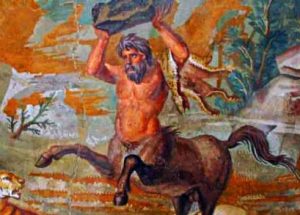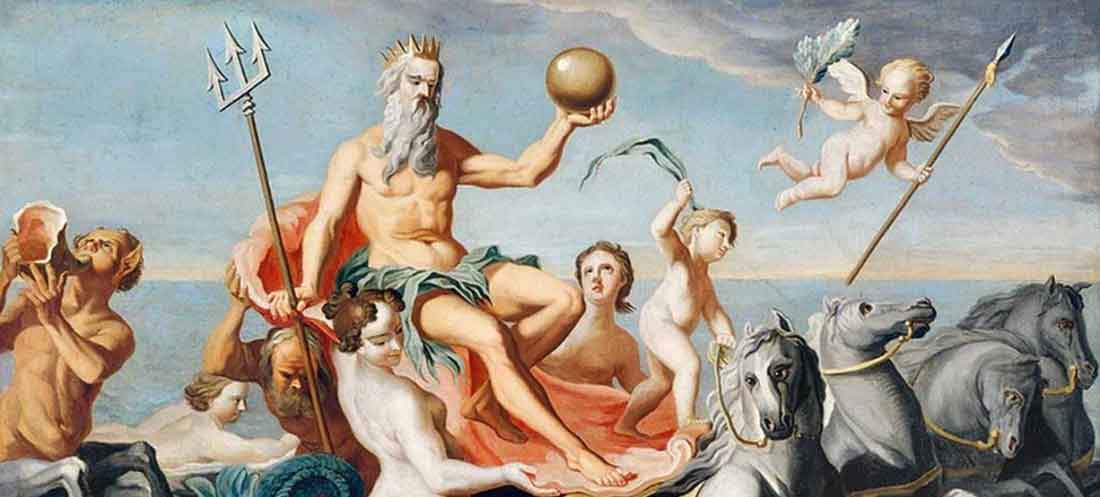The Centaurs in Greek Mythology

It seems that they were not balanced enough and are presented as primitive species that distinguished more than their animal nature. Thus, they were considered mean-spirited, thieves and misanthropes, with very few exceptions, such as that of Achilles’ mythical teacher, the Centaur Chiron. Thus their mythological presence in Thessalian land begins with a native king of the Lapiths, Ixion. Their mother was Nepheli, a cloud made by Jupiter, in the form of Hera. The Centaurs were regarded by many ancient writers as a symbol of meteorological phenomena, and this seems to be attributed to their origin from Nepheli.
The birth of the Centaurs
Once, Zeus invited Ixion to a banquet on Olympus. However, Ixion behaved very inappropriately to the father of the gods himself, trying to attack Hera! Zeus, seeing the magnitude of his wickedness, gave a nepheli (cloud) the form of Hera, as a result of which Ixion was tricked and gave birth to the Centaur from the cloud, the progenitor of the mythical monsters1. The result of all this was the eternal and irreversible punishment of Ixion. Thus, Hermes bound with snakes and not chains the punished impious man on a flaming wheel prepared by Hephaestus. This eternal punishment was closely watched by the Erinyes!
But there is also a second version about them: According to it, when Ixion was still king of the Lapiths of Larissa, a herd of furious bulls, who had taken refuge in Pelion, began to raid and destroy the agricultural crops of Thessaly. Seeing this situation, Ixion proclaimed the bulls, promising great rewards. Then a group of strong young men appeared on horseback. So they with their spears and their bows destroyed the bulls. So in the myth, they are the first to invent the “horse art” and were called Hippocentaurs or Centaurs (from “kento” – pierce and “bull”), because they embroidered or pierced (beat) the bulls. Here we see that the myth covers a historical event: the domestication of horses.
The battle of Centaurs
In the years of the reign of the Lapith king of Larissa, Peirithos, the Centaurs had spread throughout the region of eastern Thessaly, from Lake Voibeida to the shores of the Aegean. At the wedding celebration of the king with Hippodamea, daughter of Atrakus, many guests came as guests, among them the Centaurs, as well as Peirithos’ brotherly friend, Theseus.
But this marriage became the occasion of the long Lapith-Centaur war, also known as the Centaur Battle. At the wedding table, one of the Centaurs, Eurytion, after getting drunk, tried to grab the bride herself. But Theseus managed with decisive speed to save Hippodamia. Fearing the rest of the Centaurs, they left Larissa. Eurytion, however, remained a prisoner of the Lapiths and received a humiliating punishment from them. They cut off his nose and ears. After this he was allowed to leave in humiliation for Pelion. This was the occasion of the Thessalian-Centaur’s conflicts, which ended in the definitive expulsion of the latter, with the help of the god Apollo, as far as southern Pindos.
Diodorus states that, when the Centaurs were defeated by the Lapiths, they descended on Ilia and captured Pholoe. From there they robbed and killed passers-by and local residents. The inhabitants, frightened and horrified to see such monsters disappearing in the woods and streams for the first time, pictured them in their imaginations as monsters with a horse’s body.
One of the Centaurs there was Folos, the son of a Selene and the Nymph Melia, who was a friend of Heracles. Pholos was the keeper of the oversized wine cellar of the Centaurs, which Dionysus had offered them, with instructions to guard it and open it only when Heracles appeared. According to the myths mentioned by Rispen1, the wine had been given to Pholos by Dionysus, as a sign of gratitude because, as an arbitrator in the latter’s dispute with Heracles for the possession of Naxos, Pholos ruled in his favor.
Symbolism
Hybrid half-human creatures such as the Centaurs perhaps represented the negative aspects of nature in the world of the ancient Greeks. In other words, they symbolize the primordial conflict between the threatening forms of an unknown and dark world and the world of simple, for that time, rational consciousness. This contrast is perhaps best symbolized by the contrast between the Dionysian and Apollonian elements, which actually went hand in hand in ancient Greek life as necessary entertainmentand higher knowledge respectively.
Also, for the “expansionist”, whether through the colonies or simply through the superior Greek culture, the Greek heroes had to establish the presence of this cultural superiority of theirs in a wider world by transmitting it through exploits, taming mythical or supernatural creatures, which it was nothing more than the display of knowledge of them and of their power over them.
